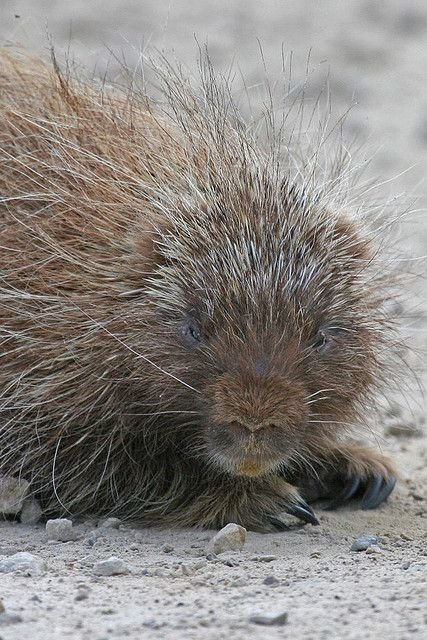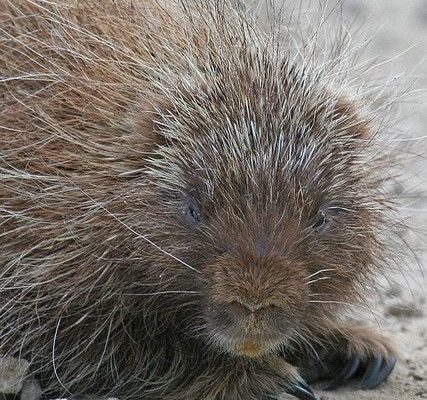
You might be surprised to learn that while they do have a strong defense mechanism, porcupines are often misunderstood. With their unique set of traits and behaviors, they deserve a closer look. So, let’s dig into the common tales about porcupines and separate fact from fiction—like peeling layers off an onion, one quill at a time!
1. Porcupines Can Shoot Their Quills
You might have heard that porcupines can shoot their quills at predators, which sounds like something out of a superhero movie. Here’s the thing: that’s simply not true. Porcupines can’t shoot their quills. Instead, they rely on a different strategy to defend themselves.
When a porcupine feels threatened, it will turn its back to the danger, fluff up its quills to appear bigger, and even make hissing sounds. If a predator gets too close, the quills can easily become detached and embed in the attacker. It’s like they’re saying, “Here, take a piece of me—just not the soft parts!” This method is pretty effective, as the quills are sharp and can cause pain or even injury.
So, if you ever encounter a porcupine in the wild, remember that they won’t shoot at you. Instead, they’re more likely to hunker down and let their quills do the talking!
2. Porcupines Are Aggressive Creatures
Another common myth is that porcupines are aggressive animals. When folks think of aggression, they often picture animals who confront danger head-on, but porcupines are more like the introverts of the animal kingdom. They prefer to avoid confrontation whenever possible.
Porcupines are generally solitary and tend to keep to themselves. When facing a threat, their instinct is to retreat or stay still rather than attack. You might be wondering, “What does this mean in real life?” Well, think of it this way: If you were at a party, would you pick a fight or try to blend into the crowd? Porcupines are more about blending in than brawling.
In fact, if you give a porcupine space, they’re likely to go about their business grazing on leaves, bark, or fruits without a care in the world. They might look tough, but they’d rather avoid drama.
3. All Porcupines Are the Same
You may have heard of various types of porcupines, but many people assume they all share the same traits. In reality, there are different species of porcupines, each with unique behaviors and habitats. The two main types are North American porcupines and Old World porcupines.
North American porcupines, for instance, tend to be larger and have a more social behavior compared to their Old World cousins, who live in Africa and Asia. Old World porcupines often live in burrows and have thicker quills that can actually protect them from larger predators.
So, consider this: when you think of porcupines in general, you might just be picturing the North American version. The differences can be pretty fascinating—like comparing apples to oranges, but with quills!
4. Porcupines Are Only Found in North America
It’s a common misconception that porcupines are exclusive to North America, but that’s not the case! These critters are found in various parts of the world. While the North American porcupine is the most recognized in the U.S. and Canada, Old World porcupines are widespread across Europe, Asia, and Africa.
Old World porcupines have adapted to a variety of environments. They can thrive in forests, grasslands, and even rocky areas. In fact, some species are more comfortable living in burrows rather than climbing trees, which is a common sight among their North American relatives.
So, if you ever find yourself in a different part of the world, don’t forget to keep an eye out for these prickly friends. They might not be the same as the ones you know, but they’re just as interesting!
5. Porcupines Are Dangerous to Humans
It’s easy to think of porcupines as dangerous due to their quills, but in reality, they’re not a threat to humans. Most incidents occur because humans don’t respect their boundaries. Honestly, porcupines are more likely to flee than confront, making them fairly non-aggressive.
Let me explain: If you happen to stumble upon a porcupine in your backyard or while hiking, your best bet is to keep your distance. These animals would rather not get involved in anything too intense. If approached, they might raise their quills, but this is just their way of signaling, “Hey, back off!”
In short, while a porcupine’s quills can cause some pain if you get too close, they’re not out to harm you. Just like most creatures, they want to be left alone to enjoy their day.
6. Porcupines Eat Only Wood and Bark
One of the myths surrounding porcupines is that their diet consists solely of wood, bark, and leaves. While it’s true that they have a fondness for these items, their diet is much more diverse.
Porcupines are herbivores, and they enjoy a variety of foods. Their menu can include fruits, nuts, and even some grains. In the fall, they may snack on apples and berries, while in winter, they’ll rely more on bark and twigs for sustenance. It’s like going to a buffet—porcupines have a choice, and they love to mix it up!
So next time you see that cute little porcupine munching away, remember they might be indulging in a gourmet meal rather than just chewing on wood.
7. Porcupines Are Lonely Animals
While porcupines are often solitary creatures, that doesn’t mean they’re lonely. Like some people who prefer their own company, porcupines are perfectly happy on their own. They mainly come together during mating season or when mothers are raising their young.
During these short social interactions, you might observe unique behavior. For example, mother porcupines are incredibly nurturing, taking care of their young until they are ready to fend for themselves. This brief bonding period reveals a softer side to these prickly creatures.
So, while they may not be the social butterflies of the animal world, porcupines certainly have poignant moments of connection, adding a warmth to their otherwise solitary existence.
Wrapping Up: Understanding Our Prickly Friends
Porcupines often get a bad rap, don’t they? From the myth of shooting quills to the idea that they’re aggressive, so much about them is misunderstood. As we’ve seen, these animals are generally peaceful, unique, and absolutely intriguing.
By recognizing the truths behind these common myths, we can foster a greater appreciation for porcupines and their role in the ecosystem. Next time you hear a story about them, you’ll know the facts and can share this newfound wisdom with friends.
So, whether you’re out in nature or just chatting with pals, remember that porcupines, like all creatures, have their own stories to tell. Happy porcupine spotting!

